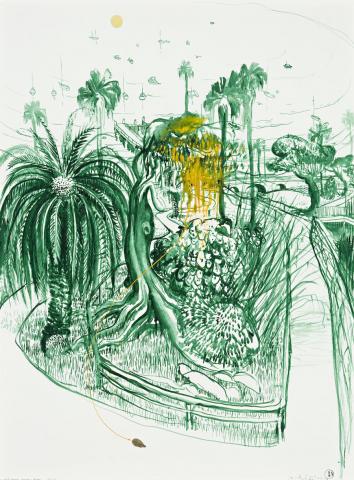THE SPLIT SECOND SUMMER BEGAN, 1979
Brett Whiteley
gouache and collage on paper on composition board
101.5 x 76.0 cm
signed and stamped with studio stamp lower right: brett whiteley 79 B/W inscribed lower left: the split second summer began Oct/22/79
Private collection, Sydney
'If in many of his other themes Whiteley confronted the difficult questions of his psyche, landscape provided a means of escape, an unencumbered absorption into a painless, floating world.'1
Exuding a sense of tranquillity, equilibrium and joyful optimism, The Split Second Summer Began 1979 is a superb example of the sensuous Lavender Bay scenes that would bring Whiteley such widespread acclaim. Returning to Australia in 1969 after a tumultuous decade abroad, such works symbolised the artist's reconnection with his homeland. More importantly perhaps, the series signalled a marked departure from art as a reforming medium 'from politics, social consciousness and a Rimbaudian vision of life as a contest between good and evil' towards tableaux strongly inspired by Matisse and his aspirations for'...an art of balance, purity and serenity, devoid of troubling or depressing subject matter, an art which might be something like a good armchair in which to relax from physical fatigue.'2 Thus, the breathtaking beauty of Lavender Bay offered a refuge for Whiteley's weary soul- the elegant, lyrical works such as the present drawing immortalising this joyous response to an optical world without pain. As Wendy later recalled, 'in a way Lavender Bay was Brett's return to paradise, having come from a very anxious situation' and it is paradise. He said some very tender things about it at the time, like 'I'm home at last...'3 From this stable domestic base, and quite literally his living room window, Whiteley now turned to the harbour for inspiration with the brilliant 'optical ecstasy' of Lavender Bay - burnt orange in the midday sun, sparkling sapphire blue at twilight or drenched pearl-grey in the rain - providing his muse.
Seduced by this new love, this enchanting siren of Sydney Harbour, Whiteley would continue over the next two decades to explore further the theme of Lavender Bay, capturing her many moods through sumptuous interiors, harbour views and still-lifes. The result was indeed his most celebrated body of work, for within three years of embarking upon the series Whiteley had won three of Australia's most coveted art awards, all with Lavender Bay paintings- the Archibald for Self-Portrait in the Studio, 1976, the Sulman Prize for Interior with Time Past, 1976, and the Wynne Prize for The Jacaranda Tree, 1977.
1. Pearce, B., Brett Whiteley: Art and Life, The Art Gallery of New South Wales, 1995, p. 196
2. Matisse cited in McGrath, S., Brett Whiteley, Bay Books, 1992, p. 181
3. Ibid., p. 48
VERONICA ANGELATOS
